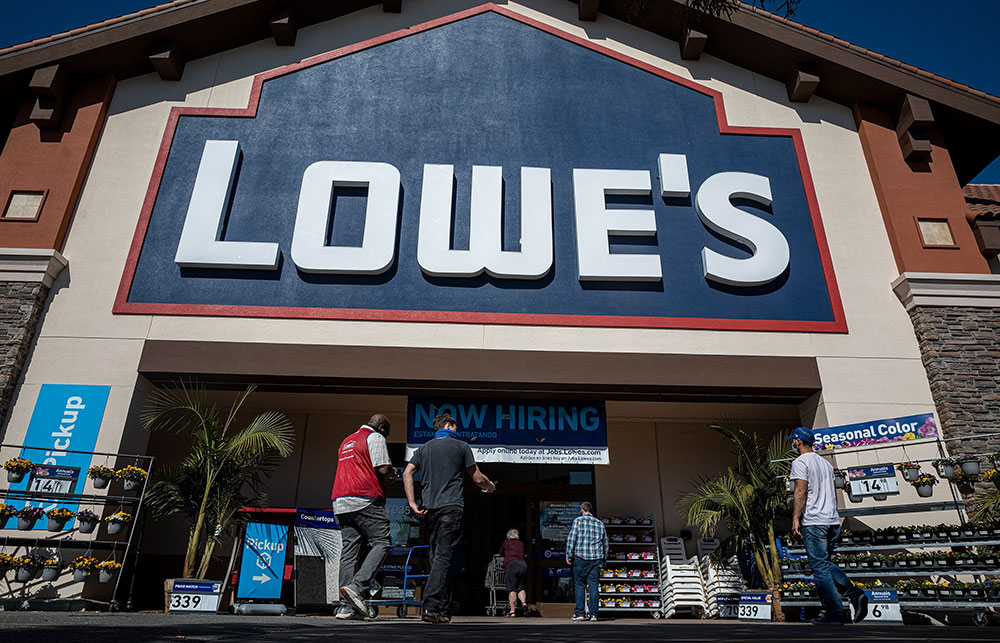疫情影响生意怎么办?这家公司从竞争对手那里抢

随着疫情消退,美国人都在准备规模更大也更昂贵的家庭装修项目,劳氏公司(Lowe’s)也有望从越来越重要的客户群,即承包商和杂工之类专业客户处争取更多业务。
2020年劳氏净销售额增长24.2%达到896亿美元,创下了历史纪录。美国人花了不少钱自己动手装修,比如在家里搭建办公室,或者粉刷孩子的卧室,这样Zoom视频会议时会看起来更漂亮。
随着自行装修业务逐步恢复正常,消费者开始转向浴室改造之类更大更复杂的项目,劳氏也及时跟进措施为专业客户提供服务。该细分市场销售额约占四分之一,但增长不如自行装修强劲。去年劳氏的“专业业务”可比销售额增长了约20%,而自行装修业务增长率还要高几个百分点。去年12月劳氏向华尔街介绍的多年计划中就提出要努力服务专业人士,巴克莱(Barclays)表示“有望全面实现”。
对劳氏来说,迎合专业顾客意味着实体店里的很大面积都要重新布置,设立带有显著标志的“专业区”。货架上要摆满专业顾客经常购买的便携工具,还有售卖止痛药、零食和能量饮料等商品的便利货架。在劳氏1734家美国门店中,95%的门店都已增加相关区域。
另一个亮点在于劳氏为专业顾客设立了专门的停车位,因为此类客户通常会买较大的商品,需要更多空间装车。此外,劳氏还为顾客提供手机充电站和专用结账区,并添加了挡风玻璃清洗站和免费充气站。
“对他们来说时间就是金钱,都希望迅速购买后快速离店,”劳氏负责销售的执行副总裁比尔·博尔茨告诉《财富》杂志。更重要的是,劳氏重新上架了专业人士喜欢的Lesco园艺肥料等产品,确保可搭配成套,供应量可满足大型项目。“最主要的工作就是确保能向专业顾客供应需要的商品,”博尔茨说。
“专业”业务本身也需要改进
劳氏希望能持续2020年热销的势头,所以解决相关挑战至关重要。劳氏最大的竞争对手家得宝(Home Depot)45%的收入都来自专业顾客,因此随着家装支出转向更复杂的项目,家得宝的收益将超过劳氏。更重要的是,家得宝最近的重大举措可能将进一步加强专业市场上的占有率,去年家得宝斥资80亿美元重新收购了之前的分公司HD Supply,该公司也是大型工业产品分销商。
虽然劳氏首席执行官马文•埃里森最近对华尔街分析师表示,不需要专业业务比例增长到总销售额25%以上,但确实希望该部分业务能缩小与竞争对手的业绩差距。长期以来,劳氏每平方英尺销售额和单店利润方面都远远落后家得宝。“提高整体效率至关重要,”2月他对分析师表示。
埃里森2018年就任首席执行官以来,他带领劳氏重振了各项业务,包括改进电商、高效布置货架,增加不用于销售但与家庭相关的产品类别,例如清洁产品等。
劳氏加强专业领域服务的背后也是同样思路。举个例子,劳氏正在更新LowesForPros电商网站并移至云端,以提供更多商品和其他福利。销售一线也提升技术支持力度,为专业顾客提供更优质的服务。今年1月,劳氏为门店员工配备了全新的顾客管理工具,能更好地跟踪购买历史和当前需求,也更容易推动升级销售。
随着疫情逐渐消退,强劲的股市和楼市让美国人越发关注自家的房子,也为劳氏提供了梦寐以求的巩固发展势头的机会。
“我们深知,对于消费者来说房子是最大的投资,人们都想舒舒服服地住在家里,”博尔茨说。舒适就意味着要雇承包商修整,需要大量材料,劳氏的希望则是人们都到自己店里买材料。(财富中文网)
译者:冯丰
审校:夏林
随着疫情消退,美国人都在准备规模更大也更昂贵的家庭装修项目,劳氏公司(Lowe’s)也有望从越来越重要的客户群,即承包商和杂工之类专业客户处争取更多业务。
2020年劳氏净销售额增长24.2%达到896亿美元,创下了历史纪录。美国人花了不少钱自己动手装修,比如在家里搭建办公室,或者粉刷孩子的卧室,这样Zoom视频会议时会看起来更漂亮。
随着自行装修业务逐步恢复正常,消费者开始转向浴室改造之类更大更复杂的项目,劳氏也及时跟进措施为专业客户提供服务。该细分市场销售额约占四分之一,但增长不如自行装修强劲。去年劳氏的“专业业务”可比销售额增长了约20%,而自行装修业务增长率还要高几个百分点。去年12月劳氏向华尔街介绍的多年计划中就提出要努力服务专业人士,巴克莱(Barclays)表示“有望全面实现”。
对劳氏来说,迎合专业顾客意味着实体店里的很大面积都要重新布置,设立带有显著标志的“专业区”。货架上要摆满专业顾客经常购买的便携工具,还有售卖止痛药、零食和能量饮料等商品的便利货架。在劳氏1734家美国门店中,95%的门店都已增加相关区域。
另一个亮点在于劳氏为专业顾客设立了专门的停车位,因为此类客户通常会买较大的商品,需要更多空间装车。此外,劳氏还为顾客提供手机充电站和专用结账区,并添加了挡风玻璃清洗站和免费充气站。
“对他们来说时间就是金钱,都希望迅速购买后快速离店,”劳氏负责销售的执行副总裁比尔·博尔茨告诉《财富》杂志。更重要的是,劳氏重新上架了专业人士喜欢的Lesco园艺肥料等产品,确保可搭配成套,供应量可满足大型项目。“最主要的工作就是确保能向专业顾客供应需要的商品,”博尔茨说。
“专业”业务本身也需要改进
劳氏希望能持续2020年热销的势头,所以解决相关挑战至关重要。劳氏最大的竞争对手家得宝(Home Depot)45%的收入都来自专业顾客,因此随着家装支出转向更复杂的项目,家得宝的收益将超过劳氏。更重要的是,家得宝最近的重大举措可能将进一步加强专业市场上的占有率,去年家得宝斥资80亿美元重新收购了之前的分公司HD Supply,该公司也是大型工业产品分销商。
虽然劳氏首席执行官马文•埃里森最近对华尔街分析师表示,不需要专业业务比例增长到总销售额25%以上,但确实希望该部分业务能缩小与竞争对手的业绩差距。长期以来,劳氏每平方英尺销售额和单店利润方面都远远落后家得宝。“提高整体效率至关重要,”2月他对分析师表示。
埃里森2018年就任首席执行官以来,他带领劳氏重振了各项业务,包括改进电商、高效布置货架,增加不用于销售但与家庭相关的产品类别,例如清洁产品等。
劳氏加强专业领域服务的背后也是同样思路。举个例子,劳氏正在更新LowesForPros电商网站并移至云端,以提供更多商品和其他福利。销售一线也提升技术支持力度,为专业顾客提供更优质的服务。今年1月,劳氏为门店员工配备了全新的顾客管理工具,能更好地跟踪购买历史和当前需求,也更容易推动升级销售。
随着疫情逐渐消退,强劲的股市和楼市让美国人越发关注自家的房子,也为劳氏提供了梦寐以求的巩固发展势头的机会。
“我们深知,对于消费者来说房子是最大的投资,人们都想舒舒服服地住在家里,”博尔茨说。舒适就意味着要雇承包商修整,需要大量材料,劳氏的希望则是人们都到自己店里买材料。(财富中文网)
译者:冯丰
审校:夏林
With the pandemic receding, Americans are poised to embark on bigger, pricier home improvement projects, giving Lowe’s an opening to win more business from an increasingly important part of its clientele: professional customers like contractors and handymen.
Lowe’s is coming off a record year in 2020, when net sales rose 24.2% to $89.6 billion. Ordinary Americans spent a ton of money on home improvement projects they could handle themselves, like setting up a new office in the house, or repainting a teen’s bedroom so it looks better on a Zoom call.
But as that part of its business starts to return to normal, and consumers gravitate to larger, more involved projects like bathroom remodels, Lowe’s is taking steps to bolster its professional customer business. It’s a segment that generates roughly one-quarter of sales but one where growth is not as strong as the do-it-yourself portion. Lowe’s “pro” comparable sales grew about 20% last year, while the DIY business grew several percentage points more. A more concerted effort to woo pros was part of a multiyear plan Lowe’s presented to Wall Street in December that Barclays has said “delivers on all fronts.”
For Lowe’s, catering to pro customers has meant remodeling big sections of its mammoth stores to set up “Pro Zone” areas with prominent signage. These are stocked with the grab-and-go items pros frequently buy and convenience racks with items such as painkillers, snacks, and energy drinks. Lowe’s has added such sections to 95% of its 1,734 U.S. stores.
Another touch: Lowe’s has set up dedicated parking spots for these customers, who often need to load bigger items into their vehicles. There are also phone-charging stations for these customers and a dedicated checkout area. Lowe’s is adding windshield cleaning stations and free air stations as well.
“Time is money for them, and they want to get in and out of the store quickly,” Lowe’s executive vice president of merchandising Bill Boltz tells Fortune. What’s more, Lowe’s has brought back brands pros prefer, such as Lesco fertilizer for landscapers, and has focused on making sure these items are in job-lot, or sufficient, quantities and are reliably in store for big projects. “One of the biggest [efforts] is to make sure we have what the pros are looking for,” says Boltz.
The ‘pro’ business has needed improvement of its own
Addressing this challenge is of utmost importance to Lowe’s if it wants to maintain the momentum it gained from a blockbuster 2020. Its chief and bigger rival, Home Depot, gets 45% of revenue from pro customers, so stands to gain even more than Lowe’s as home improvement spending shifts to more complex projects. What’s more, Home Depot recently made a big move that could strengthen its hold on the pro market, buying back HD Supply, a former division and a large industrial products distributor, for $8 billion last year.
While CEO Marvin Ellison recently told Wall Street analysts he doesn’t need the pro business to grow to more than 25% of Lowe’s total sales, he does want that part of the business to improve its financial performance compared with rivals. Lowe’s has long lagged Home Depot in terms of sales per square foot and profit per store in no small part because of that. “It’s going to be critical for us to improve overall productivity,” he told analysts in February.
Since Ellison became CEO in 2018, Lowe’s has reinvigorated its overall business, with moves such as improved e-commerce, more efficient restocking of shelves, and adding product categories it didn’t use to sell but that are connected to the home such as cleaning products.
That same ethos is behind Lowe’s push to lift the pro business. For instance, Lowe’s is updating its LowesForPros e-commerce site and moving it to the cloud so it can offer more items, among other benefits. On the sales floor, there have also been tech moves to better serve pros. In January, Lowe’s equipped store workers with new client management tools that help them better keep track of a customer’s history and ongoing projects, and make it easier to upsell.
As the pandemic recedes, the strong stock and housing markets are keeping Americans focused on their homes, presenting Lowe’s with a dream opportunity to build on its momentum.
“We know the home is the single biggest investment for consumers, and they want to make sure that they are comfortable in it,” says Boltz. And that means hiring contractors in need of tons of supplies, which they will, the retailer hopes, get at Lowe’s.













